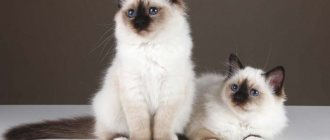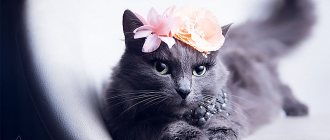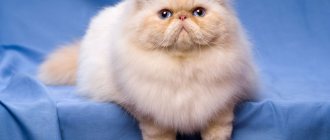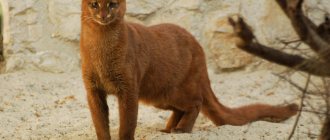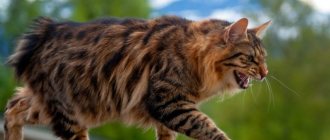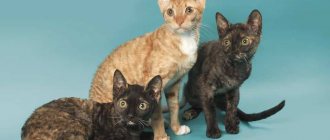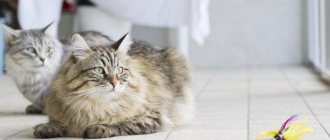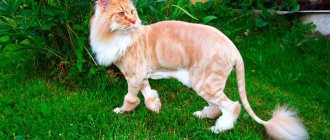There are several popular cat breeds that originate from Russia. For example, Russian blue cats are known all over the world, but the Ussuri cat rarely finds itself as a companion. Russian cat breeds differ both in appearance and in temperament, because they appeared in different parts of Russia from different ancestors.
10 Russian cat breeds
If you want to adopt a rare and unusual cat, it is better to first meet a representative of the breed. You will be able to understand how her character will fit with your lifestyle.
Kurilian Bobtail
The Kurilian Bobtail is a naturally occurring breed. These cats have lived for more than 200 years on Sakhalin Island and the Kamchatka Peninsula. They also live in the Kuril archipelago, connecting Russia and Japan. They look like predators, but in fact they are calm and affectionate. However, their instincts are well developed and they have high energy.
General characteristics
- HEIGHT : 23 – 30 cm
- WEIGHT : 4 – 8 kg
- APPEARANCE : soft, silky short to medium length coat; characteristic short tail; color red or gray with stripes
Development of felinological organizations in Russia
The first Russian cat lovers club is considered to be the non-profit association of animal lovers “Fauna”. It was on the basis of this association that a separate section was created in 1986, including only “cat people.” The very next year, Fauna organized the first cat exhibition in Moscow. It is noteworthy that among the 300 cats participating in the exhibition, only a few had any breed characteristics, while the rest were “ordinary domestic cats.”
For many years, Russians have been among the ten most cat-loving nations.
In 1989, the “Soviet Felinological Federation” was organized in Moscow, whose president was Eldar Razroev. Subsequently, the association changed its name and became the “Felinological Association of Russia”. FAR relied heavily on the experience of foreign colleagues, in particular from Germany. And by 1992, the FAR was recognized as an active member of the WCF.
Until 1986, sections and associations of cat lovers spontaneously arose in different regions of Russia. However, their work was temporary and spontaneous in nature. Therefore, there is no need to talk about any scientific approach to the study of cats.
That is, FAR “grew up” from one of the hundreds of cat lovers’ clubs that appeared in the cities of the USSR in the 1980s. And today this organization continues its work within the framework of the tasks identified by felinologists around the world, taking into account the climate and natural features of the territories of Russia.
Russian approach to selection
It is believed that the domestic cat first set foot on the soil of Rus' back in the 11th century. From chronicle sources it is known that the mustachioed pet was brought to Rus' from across the seas on ships. Cats have long lived on ships to kill rodents. This ability, as well as soft fur and purring, made cats literally the leader among all the animals that surrounded man of that era.
But despite such a long stay of cats in Rus', the breeding of new breeds and the improvement of existing characteristics in the USSR began only at the end of the 20th century. Today, more than 20 cat breeds are officially bred in Russia, and Russian cats have as many as 500 color options. Therefore, it is not surprising that Russian breeds are very popular all over the world.
Historians believe that the very first indigenous cat breed in Rus' was the Russian Blue. That is, the breed was formed under the influence of natural conditions with little human participation. There are historical sources indicating that the Russian Blue cat was a favorite at the court of Catherine II. However, some written sources call the breed “foreign blue,” which indicates its foreign origin. Although there is another point of view: the Russian Blue traces its ancestry to cats in the Arkhangelsk region.
This breed is considered the very first native Russian cat breed.
The second native Russian native breed is the Siberian cat. It was these “basic” breeds that became the progenitors of many famous cat breeds.
Aboriginal breed with Russian roots
A number of Russian cat breeds originate from “native” animals. This curious feature of Russian felinology made it possible to crossbreed even with wild cats. A distinctive feature of Russian breeds can be considered a very short pedigree (often no further than 4 generations). This is due to the “youth” of the breeds. In this regard, many kittens are sold without documents, which undoubtedly affects the gene pool of the breed and increases the risk of buying another “motherless” pet.
We can say that the original Russian approach to cat breeding involves improving some of the natural qualities of animals and fixing them at the genetic level. It is worth noting that almost all the main breeds bred in Russia have in their name one or another toponym associated with the territory of breeding - for example, Neva Masquerade (Neva River), Ural Rex (Ural Mountains), etc.
Breed diseases
Forest cats are strong, resilient and stress-resistant, and have strong immunity. But with poor diet and lack of exercise at home, there are risks of developing a number of diseases and pathological conditions:
- Cardiomyopathy is a heart pathology.
- Glycogenosis is a problem associated with impaired glucose metabolism in the body.
- Renal polycystic disease is a cystic neoplasm localized in the kidney area.
- Retinal dysplasia is a pathology leading to deterioration of visual function.
- Disorder of calcium-phosphorus metabolism processes, fraught with frequent fractures and traumatic injuries.
You should know that Amur cats react negatively to anesthesia and various types of surgical interventions.
Forest cats are beautiful, rare, noble animals that, even while living at home, retain their independence and love of freedom. With the right approach and proper care, such an animal can become a reliable family friend for many years, because the average life expectancy of representatives of the breed is about 30 years.
Russian cat breeds
Russian cat breeds are very beautiful. Contrary to popular belief that “everything is better in the West,” domestic fluffies are in no way inferior to foreign breeds in beauty or ingenuity. However, it is worth paying tribute to the fact that most breeds have the roots of outbred cats, which is reflected in their character traits: Russian cats can be somewhat capricious and capricious.
Russian blue
The breed is considered one of the most famous throughout the world. Despite the name, English breeders once had a hand in breeding the Russian Blue, but over the last few centuries the breed has been practically independent of human actions.
Cats have thick and very beautiful gray-blue fur. The breed has no other color standards. The fur shimmers a little, which gives the animal a slightly mystical appearance.
The Russian Blue has a soft and flexible character, but in some cases it can be stubborn if the owner, in her opinion, acts “wrong.”
The characteristics of the breed are considered not only the unique coat color, but also a number of external features and structure:
- elongated body, graceful constitution;
- a long tail that tapers very strongly at the tip;
- long paws with rounded pads;
- elongated skull with oval eyes;
- large ears with a small amount of hair on the inside;
- Double coat (undercoat and outer coat).
Disadvantages of the breed include white spots on the body, a stocky body and round eyes. The following may lead to disqualification of a representative of the breed:
- abnormal number of toes;
- amputated claws;
- aggressive behavior;
- white spots over 1 cm in diameter;
- dyed or shaved wool.
The cost of Russian Blue kittens varies between 8-35 thousand rubles.
The silvery coat makes this breed a very beautiful and graceful animal.
Siberian
The Siberian cat is a semi-long-haired breed. It is believed that the ancestors of the breed appeared in the dense forests of Siberia and, one might say, independently developed all the characteristics that Siberians possess today.
These are very large cats: the weight of an adult pet can reach 12 kilograms. The main feature of the breed, however, is not the weight of the animal, but its coat - thick and warm with an excellent undercoat that will protect against any frost. At the same time, the obligatory attributes of a Siberian cat are thick “pants” and a “collar”, as well as hair between the toes and tassels on the ears.
The body structure of Siberians is subject to the general standard for the breed:
- muscular torso;
- the hind legs are slightly longer than the front legs with powerful toes;
- the head is rounded, there is a small notch on the nose;
- ear size - larger than average;
- proportionally folded skeleton;
- almost round eye shape.
The breed is hypoallergenic, as evidenced by numerous owners and breeders.
The breed has many color options: both solid and multi-colored. Only lilac, cinnamon, fawn and combinations with white are unacceptable.
The Siberian cat requires careful grooming: the owner will have to comb the pet’s fur daily and bathe it periodically.
The character of Siberians is soft and affectionate, there is no aggression or capriciousness. All this, as well as hypoallergenicity, make it possible to keep cats of this breed in families with small children.
Siberian cat kittens are sold for 10 thousand rubles.
Neva Masquerade
The Neva Masquerade is considered a direct descendant of the Siberian breed. And the name “masquerade” is due to the unusual color of the face - as if the cat is wearing a mask from a carnival. The breed began to be bred in 1989 in St. Petersburg, which gave the breed its second name - “Neva”.
The main advantage of the breed is considered to be its unusual color-point coat and bright blue eyes. At the same time, different shades of blue are allowed - from light blue to rich sapphire.
One of the main advantages of the Neva Masquerade cat is the hypoallergenic nature of its fur (which, perhaps, confirms its relationship with the Siberian cat). In addition, the most important characteristics of the breed are:
- strong and muscular body of medium length;
- medium-length paws with tufts of hair between the toes;
- wide chest - in general, the torso together with the limbs forms a proportional rectangle;
- trapezoidal head shape;
- medium-sized ears, often with tassels at the ends;
- rounded eye shape.
The breed has a total of 6 coat colors, among which the most common are seal point, red point, blue point and tortoiseshell point. White ends of the paws and muzzle can be found in all masquerade cats.
Docile and kind in nature, cats are considered excellent companions for people.
Masquerade Neva cat kittens cost from 2 thousand rubles for an individual without a pedigree to 25 thousand rubles for an animal with a passport.
The beautiful coat of the Neva Masquerade and the unusual print of the face make the breed very popular in private keeping.
Don Sphynx
The breed was bred in 1990 in Rostov-on-Don, for which it received its name. Cats are hairless, which is somewhat unconventional for Russian breeds.
The characteristics of the Don Sphynx breed are:
- developed muscles;
- silky to the touch skin, completely devoid of hair;
- long and graceful limbs;
- long bare tail;
- large ears;
- slanted eyes.
It is important that there are a number of fundamental differences between the Don and Canadian sphinxes:
- In Canadians, the baldness gene is recessive.
- Canadians are not completely hairless animals; they are covered with short hair, which is especially noticeable on the paws, face and ears.
- Only the Don sphinxes have hunger births.
The Don Sphynx becomes very attached to its owner and follows him everywhere. However, due to the lack of a fur coat, cats cannot be allowed outside: they are purely domestic pets.
Kittens of this breed cost from 9 to 30 thousand rubles.
A breed of hairless cats bred in Russia
Peterbald (Peterbald)
Peterbalds are direct descendants of the Don Sphynx, bred in St. Petersburg in 1994. At the same time, breed standards allow both a complete absence of hair and a variety of skin covering options: brush, velor or flock.
Peterbalds are distinguished by their intelligence and intelligence. At the same time, like real St. Petersburg residents, cats are very intelligent and will not bother their owner. They easily tolerate all games with children, preferring to withdraw rather than use their teeth and claws.
The following characteristics give the breed elegance:
- lack of hair or minimal body fur coverage;
- long legs;
- narrow and elongated head shape;
- almond-shaped eyes;
- ears spread apart;
- secretion of skin lubricant and its accumulation at the claws or in the ears;
- the color appears directly on the skin if there is no fur.
The average price for a Peterbald kitten is 15 thousand rubles.
The appearance of a cat of this breed resembles an alien
Kurilian Bobtail
The Kuril Islands are considered the homeland of this cat breed. The Kurilian Bobtail is very similar to a small lynx, which made the breed one of the most popular on the threshold of its discovery in the 1980s.
It is important to understand that the bobtail has the temperament of a predator and loves outdoor games. At the same time, the cat becomes tenderly attached to its owner and can even protect him from strangers. Specific characteristics of the breed are:
- large massive body;
- arched back;
- short but thick tail;
- tassels on the ears;
- powerful paws.
The Kurilian Bobtail can be either short-haired or long-haired, and there are many colors characteristic of the breed.
A kitten of this breed is estimated today at between 8 and 15 thousand rubles.
Kurilian Bobtails look very original with their short tail and small tassels on their ears.
Karelian Bobtail
The standard of this breed was first described in 1987 in St. Petersburg. As a matter of fact, the Karelian bobtail is a mutation of the short-tailed Kuril bobtail, which itself appeared in the wild near Lake Ladoga (Karelia).
Today, the number of Karelian bobtails is extremely small: only one nursery in Karelia and the Kotofey cat lovers club in St. Petersburg are engaged in breeding and improving breed data in Russia.
The Karelian Bobtail is a medium-sized cat with a short tail. In addition, obvious signs of the breed are:
- narrow head shape in the form of a triangle;
- long hind legs and short front legs;
- large ears with small tassels;
- short coat with thick undercoat;
- oval eye shape - the eye color must be combined with the color of the fur.
All types of colors are recognized, except chocolate, lilac, fawn, cinnamon and color point.
Karelian Bobtails differ from their ancestors, the Kurilian Bobtails, in a number of important features:
- the body is smaller and more graceful;
- straight back without bends;
- thinner paws;
- large ears, set very high on the head.
Due to the rarity of the breed, an individual Karelian Bobtail can cost from 20 thousand rubles.
The bobtail from Karelia also closely resembles a lynx
Peterbald
Peterbald has a second name - the St. Petersburg Sphynx; these cats have a naked body. Characteristics of the breed:
- mind;
- playfulness;
- devotion;
- friendliness to both people and other animals.
The Peterbalds love children. They allow themselves to be picked up and stroked. Sphinxes treat all family members equally well.
How to choose the right kitten
It is advisable to buy a Russian Blue from a specialized nursery or from a trusted breeder with an impeccable reputation. At the time of sale, the baby must have a veterinary passport with vaccination marks and a metric confirming its breed.
The three-month-old blue kitten has green eyes, a straight tail without kinks and fur with traces of silvering. The physical health of the baby can be judged by a soft belly, clear eyes and clean skin without scratching or redness.
Kitten care
Caring for a kitten of this breed is not as difficult as it seems at first glance. Usually, by the time the kitten is weaned from its mother and moves to a new home, it is already accustomed to the litter box and knows the scratching post. Therefore, new owners can only show the pet where its toilet, place to sleep and bowls of food are located.
To ensure safety, all wires, household chemicals and small objects that the kitten might mistake for a toy are hidden from the kitten. And to make caring for the animal easier, they purchase in advance:
- scratching post;
- tray and filler;
- bowls for food and water;
- house or bed;
- toys;
- carrying bag;
- hygiene products;
- grooming tools.
Toy bob
The peculiarity of the Toy Bob breed is its miniature size. An adult animal is the size of a six-month kitten. The second distinctive feature: the tail is 3-7 cm long. Moreover, it can be spirally twisted.
Main characteristics:
- strong body;
- developed muscles;
- proportional head and ears;
- short muzzle;
- dense wool.
Eye color is bright blue. Toy beans love communication, quickly become attached to their owners and love to be the center of attention. They are not prone to aggression; males do not mark territory.
Neva Masquerade
A young breed that was bred only at the end of the last century. It received its name from its place of origin (St. Petersburg) and because of its color characteristics. Dark hairs grow on the face, reminiscent of a masquerade mask. These cats have very thick and long hair. Especially lush on the chest, tail and hind legs.
Neva Masquerade Dogs are distinguished not only by their beautiful appearance, but also by their wonderful character. They:
- sociable;
- unobtrusive;
- smart;
- loyal to their owners;
- absolutely unforgiving.
Thanks to their high level of intelligence, cats quickly get used to their name. Having remembered the nickname, they do not respond to any other calls, especially from strangers. Neva Masquerade Dogs are very friendly. They get along well with other pets - cats or dogs.
Care and maintenance
The blue cat does not take up much space and easily adapts to any living conditions. And so that she always remains attractive and healthy, she is provided with adequate nutrition and basic hygiene.
Hygiene procedures
The eyes and ears of a cat of this breed are regularly examined for the presence of purulent or unpleasant-smelling discharge and wiped with a moistened cotton pad.
The animal's teeth are cleaned twice a month with a special brush with a small amount of toothpaste that does not foam. This procedure helps prevent the appearance of yellowish plaque and stone.
Cat's claws deserve special attention. They are periodically trimmed with a nail cutter, carefully removing the upper edge of the plate. If living tissue was accidentally touched during the procedure, the damaged area is treated with hydrogen peroxide.
Grooming
Although this breed loves water and can spend hours watching it flow from a tap, they should not be bathed frequently. Russian Blues are given bath treatments only in cases of severe contamination or in preparation for exhibitions.
In any other situations, complete washing is replaced by using dry shampoos.
To make the thick coat look silkier, the cat is brushed at least once a week.
Note: after brushing, some owners run a piece of velvet or suede over the pet’s fur to make the thick fur shiny.
Tray
A deep tray with high sides is suitable as a toilet for the Russian Blue. You can use wood filler or the one that the breeder trained your pet to use.
The litter box must be kept perfectly clean, otherwise the cat will choose another place for the toilet.
Siberian
The Siberian cat is a breed that is popular not only in Russia. These pets are loved for their beautiful appearance and wonderful character. These animals are very sociable and friendly, without vindictiveness. They are distinguished by good health and ease of care.
A distinctive feature of the breed is its very thick and long coat, which makes it easy to withstand even extreme cold. It is believed that the appearance was influenced not by artificial selection, but by nature itself. Relationship with wild cats is indicated not only by color, but also by physique. Siberians have it compact and powerful. The resemblance to a lynx is added by the presence of tufts on the ears.
Don Sphynx
The Don Sphynx is a hypoallergenic breed. They differ in their specific appearance:
- massive body;
- big ears;
- blue-gray skin;
- folds on the paws, neck and muzzle;
- a long tail.
The peculiarity of the Don Sphynx is its tightly clenched toes, which resemble human ones. The character is dominated by playfulness and independence. The animal is smart, but difficult to train. This breed is believed to be good at relieving fatigue, headaches and nervous tension.
Ural rex
The Ural Rex is a breed with a rather unusual appearance. The peculiarity of cats is long wavy hair. The muzzle is slightly elongated, with well-defined cheekbones and a strong chin. Eye color always matches the main color.
In addition to their original appearance, the Ural Rex also has an interesting character. They are not picky, easy to train, and get along well with people and animals. And their fur does not cause allergies.
